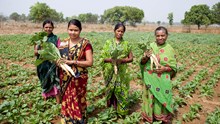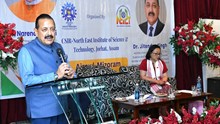
According to India’s official Ground Water Resources Assessment, more than one-sixth of the country’s groundwater supply is currently overused, which is forcing cities to go for temporary measures like water imports, which has economic implications. Another study of the World Bank’s says water scarcity can affect long-term economic growth prospects. Water scarcity will cost India 6 per cent of its GDP if the country continues to mismanage water resources by 2050. The major impact will be on health, agriculture, income and property.
Water is one of the most important elements for the growth of the agriculture sector.
Even good quality seeds and fertilizers will have no value if plants fail to get sufficient amount of water. Animal husbandry and fisheries, too are heavily dependent on them. Research says that India accounts for about 17 percent of the world’s population but only 4 percent of the world freshwater resources. Sadly,India has huge water resources, but none are evenly distributed across the vast expanse of the country.
The escalating demands of water resources due to an ever-increasing population, diminishing quality of existing water bodies because of alarming pollution levels, all have created a situation where water consumption is increasing every day, but its supply remains a debatable question. Surveys conducted by the Tata Institute of Social Sciences (TISS) showed most of the urban cities are water deficient. Nearly 40 percent of water demand in urban India is met by groundwater. As a result, groundwater tables in most cities are falling at an alarming rate of 2-3 meters per year. Many large cities like Hyderabad, Chennai, Coimbatore, Vijayawada, Amravati, Solapur, Shimla, Kochi are moving towards an acute water crisis. Climate change, early summer, deficit rain-fall, depleting water level, rising population and lack of water management policy is making it difficult for the urban local bodies to meet the increasing demand for water. According to a World Bank report, at least 21 Indian cities are moving towards zero groundwater level by 2020, which has already set the alarm bell ringing for policy makers and urban planners.

The negative impacts due to water scarcity are in plenty. It is badly affecting the environment, including lakes, rivers, wetlands, and other freshwater resources. Not only this, it is also found that many places in India suffer from water shortage because of water overuse. It mainly occurs in areas of irrigation agriculture and damages the eco-system in numerous ways including increased salinity, nutrient pollution, and the degradation and loss of floodplains and wetlands.
In addition, water shortage also affects the process of flow management and creates hurdles in the rehabilitation of urban streams. Owing to poor water resource management system and climate change, India faces a persistent water shortage. A report by OECD environmental outlook 2050 predicts that India would face severe water constraints by 2050. Indian agriculture accounts for 90 percent water use due to fast-track groundwater depletion and poor irrigation systems.
When speaking of Latur, one of the districts from Marathwada region in Maharashtra, challenges such as poor monsoon, over-exploitation of groundwater and lack of policy planning have forced the Latur Municipal Corporation to announce that they can provide water only once in a month. The crisis forced the government to send water through railways and a large number of farmers and residents had to move out of the city, bringing the city's economy to a standstill. And while the focus remained on Marathwada in general and Latur in particular, Maharashtra’s total water storage has gone down to 30 per cent and in many districts, sources of water have dried up completely. A report by World Resources Institute, says 54 percent of India’s total area is under high to extremely high-water stress and groundwater levels are declining in 54 per cent of wells across India. The study further says that water demand in India will reach 1.5 trillion cubic meters in 2030 while India’s current water supply is only 740 billion cubic meters.
According to India’s official Ground Water Resources Assessment, more than one-sixth of the country’s groundwater supply is currently overused, which is forcing cities to go for temporary measures like water imports, which has economic implications. Another study of the World Bank’s says water scarcity can affect long-term economic growth prospects. Water scarcity will cost India 6 per cent of its GDP if the country continues to mismanage water resources by 2050. The major impact will be on health, agriculture, income and property.
We are sitting on a boiling volcano, whose name is water, which can burst any time. It’s time that we think and act towards the judicious use of water and rainwater harvesting. If every individual takes this oath that we will collect every single drop of rain, then we will save 70 percent of the rainwater, which is carried out through the rivers in the sea and we will be able to fulfil our water requirements as well as reduce the water load on earth. Currently, we are exploiting 251 billion cubic meters (bcm) of groundwater in 2010, whereas the United States extracted only 112 bcm. Further, India’s rate of extraction has been steadily growing from a base of 90 bcm in 1980 while this rate in the United States has remained as more or less the same level since 1980.
The India Meteorological Department (IMD) has forecast a ‘normal’ monsoon this year. Rainfall is envisioned at 97 percent of the long period average (LPA), which is a positive sign for the agricultural sector and the rural economy. Monsoon has knocked on Kerala and we are hoping that soon, India will be happy with the drops of rain. So, this monsoon, let’s start with harvesting water and create a secured future for the upcoming generation.












Share your comments